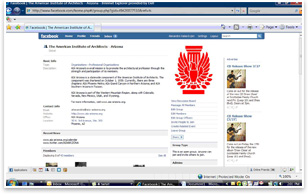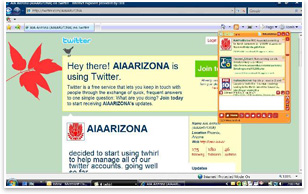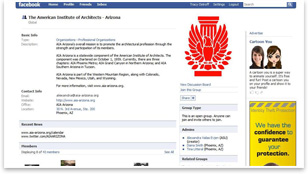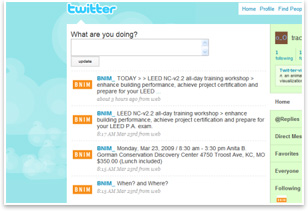Social Media Sites May Help Build Networks, Connections
by Tracy Ostroff
Contributing Editor
 How do you . . . leverage social media applications? How do you . . . leverage social media applications?
Summary: In an economic environment where no business lead or possible relationship should be left unturned, communications directors of firms and AIA components say they are increasing their presence on social media sites such as Facebook, Twitter, Flickr, and LinkedIn. It is part of a strategy to seek connections and an extension of their brand and the way they already do business.
Challenging economic times call for innovative approaches to marketing design services, broadcasting events, and forging connections that can benefit a practice. Some firms and AIA components are using social media tools to broaden their networks and pursue business opportunities. Social media is the term that refers to dynamic on-line tools that allow users to generate content—documents, images, videos, podcasts, and more, depending on the site—and share it with others with whom they have shared interests or networks.
“We’ve seen a major increase in the use of our Facebook site since the economy took a turn for the worse,” says Michael Din, director of development and marketing at AIA Los Angeles. The AIA Los Angeles Facebook site, up now for six months, is up to 470 members, and the chapter uses it to announce events and as a forum for member connections. They also use the Constant Contact e-mail service for news and member alerts. Recently, Din reports, the owner of a high-end group of restaurants from outside the country called the chapter after seeing one of the component’s updates on its Restaurant Design Awards to ask for recommendations of a Los Angeles-based architect for a new Southern California project. “That’s a great lead for our membership,” Din says.
 Embracing social media Embracing social media
As architects become more aggressive about finding work, they are taking a greater interest in developing relationships in ways that might get out of their comfort zone. AIA Arizona is one chapter that is leaving no stone unturned as it helps members become more familiar with a Web 2.0 world.
It may be daunting to get started, says Alexandra Evjen, AIA Arizona’s communications director, but worthwhile. She says it is a slow process for which you have to think about placing in a public site pertinent information for potential clients, peers, and the public at large. Architects may want to post images and descriptions of their projects, event notices, or other takeaways in their niche areas. On Facebook, people can become “friends” or “fans” of your page, and they see new content as it is added. Privacy settings can help.
Stronger Web presence
For example, Memphis-based Askew Nixon Ferguson Architects has a robust Facebook site that offers folders with images of its art shows and large charity events as well as information about the programs and the firm’s architecture projects, such as the grand opening of one of its new university residence halls. The well-organized Facebook presence markets ANFA in the online world and complements the firm’s Web site.
ANFA Communications Coordinator Ciara Neill says she had to take the idea “up on the big screen” for the partners, but soon got enthusiastic approval. The firm has hundreds of people who have “friend” requested them. “We try not to do too much to turn people off. The firm does not do any direct marketing through Facebook, but does post projects of recently completed projects and recently invited its friends to the opening of Christian Brothers University.”
AIA Arizona uses WordPress for a blogging site and to help members build a stronger Web presence through which they can interact with the public. The component is also looking to up its profile on YouTube, which Evjen notes is the second largest search engine. They have recently purchased video conferencing equipment that she hopes will help the chapter post rich video content. Further extending their reach, AIA Arizona just started to use vBulletin earlier in March to “get a conversation going with the public.” It’s in the soft launch phase now.
Other members are using Twitter (also know as tweeting) to reach the public at large. Evjen says she uses the free social networking service to send posts about component events. She has also used the Twitter’s search function to mine the site for people who are talking about the AIA Arizona. In one case, a member was frustrated with the AIA and wrote about the experience on Twitter (within the site’s 140 character per “tweet”). Evjen was able to reply and ask: “How can we better serve you?” In this economy, Evjen says, “customer service is going to be everything.”
 Make it relevant Make it relevant
Evjen says the key to social media is keeping information relevant and updated. They have found, however, there is a tipping point when they get pushback from members who are frustrated with the number of messages they get from the chapter. The rules of marketing etiquette still apply, it would seem, for the most part, to new online networking tools.
“This doesn’t replace face-to-face communications. It’s a way of meeting up with that old college friend or someone who may have worked with you and focusing on how that person can extend your practice’s reach,” Evjen says.
Kansas City-based BNIM, is on Twitter and Facebook. Director of Communications Erin Gehle says her firm views their presence on the sites as a “natural extension of the communication that we are already doing.” She adds, with the nature of the media, and the time and care it takes to nurture the sites, “the participation has to be organic.”
So far, there is just one designated tweep, or person who sends out the messages on Twitter for BNIM. Gehle describes the designer as someone who “just knows what to say,” to give a “glimpse into the moment” of what’s going on at the firm. Sometimes it’s a simple: “Have a good day.” Other times, the tweets offer dates for upcoming LEED seminars, provide information on presentations by BNIM staff and executives, or share information about firm projects and accolades.
BNIM, which is spearheading the LEED-Platinum revival of Greensburg, Kans., as well as many other high-profile sustainable initiatives, has received interview requests in response to Twitter posts from editors and writers, especially in Europe, who are mining the sites for story ideas. They have also pursued project leads. No work has come in yet, but they are “building a larger relationship and personal connection that may eventually come to pass,” Gehle says.
“It’s a way to promote our business and promote company culture,” Gehle says. The firm has hundreds of followers on Twitter, and BNIM increases its network by subscribing to other feeds who, in turn, check them out. The feeds “spring connections.” The firm is also reaching out to and connecting with employees and their networks on Facebook. As part of their overall communications strategy, Gehle notes that they are also considering launching a blog, but decided to jump in with social media first. “Blogging takes more time and requires more editing.”
Gehle and AIA Arizona’s Evjen say they also have a presence on other social media sites, like LinkedIn, and says although the latter site has value possibly for individuals, it is too static for the group content they are in charge of promoting.
For the future, Gehle says social media sites are necessitating that users post to their pages information and tools that visitors can take with them. She says her firm is looking to offer such content and integrate it with a rich Web site that can take advantage of the many ways in which consumers are seeking information, such as videos and blogs.
 Getting started Getting started
To be sure, it’s a learning curve for those dipping their toes in social media, and like any other online application, you will want to consult the terms of service and privacy policies for each site. Once considered the province of generations starting with x and y, as well as tech-philes, more firms are blogging, sharing images and information on Facebook, and broadcasting event details on Twitter. To help bridge this gap, AIA Arizona is helping any of its members with setting up accounts and is working on programs to connect the chapter’s Young Architects, usually better versed in social media, with those who are just getting started, often more seasoned members. It is creating a two-way mentoring opportunity that Evjen says she hopes will extend beyond this endeavor.
Evjen says the component is also offering seminars on sites that can possibly help members reduce overhead. Classes will touch on ways to use Skype, which in many cases allows you to make free calls over the Internet, and various Google tools that allow users to track Web site visits. She is also helping members familiarize themselves with the WordPress, publishing platform through which architects can build an entire Web site and blog presence.
Social connections
For those people afraid that social networking sites blur too much the separation between personal and professional, JP Ward, AIA, the head of the architecture department of Anthony Wilder Design Build Inc., Cabin John, Md., says there is value in sharing a wide variety of information on a public site like Twitter. He might share a quick review of a restaurant or play, in addition to tweets about when his firm is featured in the news or on design shows on HGTV. It’s all part of an effort to introduce people to his firm and make potential clients and vendors comfortable working with them.
Evjen echoes that sentiment for AIA Arizona, noting that social networking sites help foster familiarity because users can ascertain a wealth of information about the practice and the people who work there.
Firms and components also stress that it takes one champion to make it all come together. Evjen, who has assumed that role in her office, says the changing market will make people more aware of opportunities. ANFA’s Neill calls it “sidelong marketing into people’s brains.”
|


 How do you . . .
How do you . . . Embracing social media
Embracing social media Make it relevant
Make it relevant Getting started
Getting started